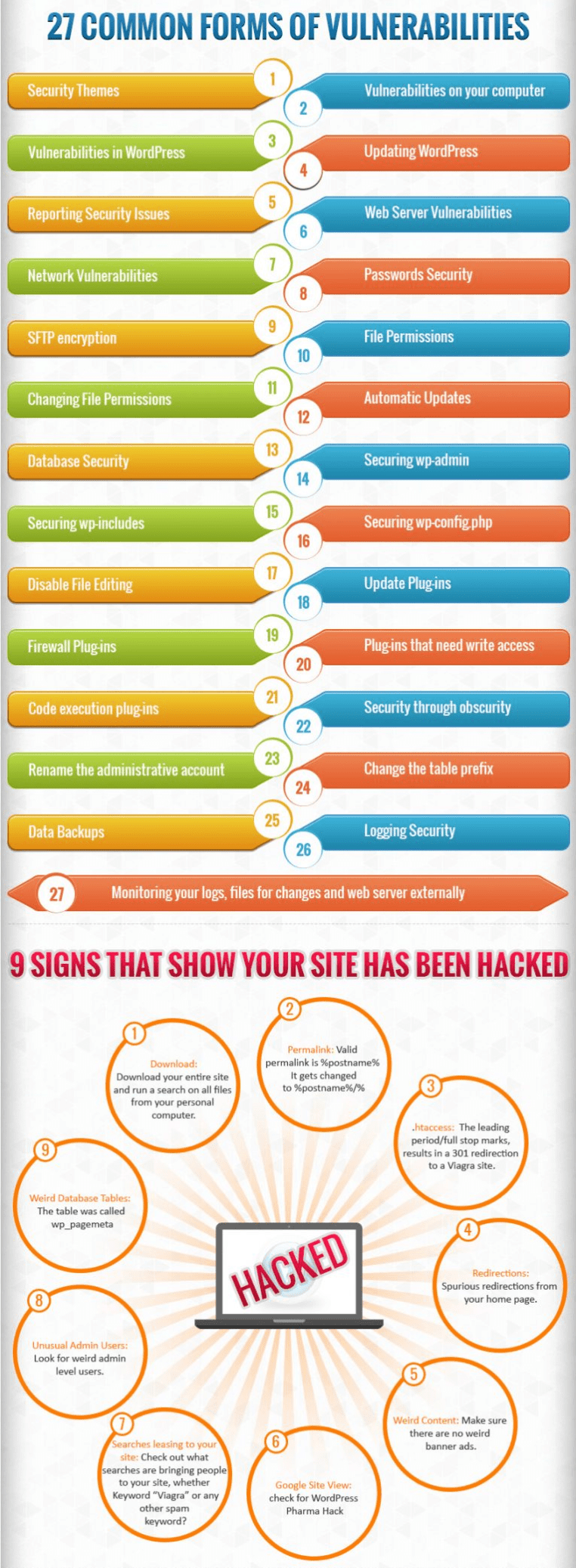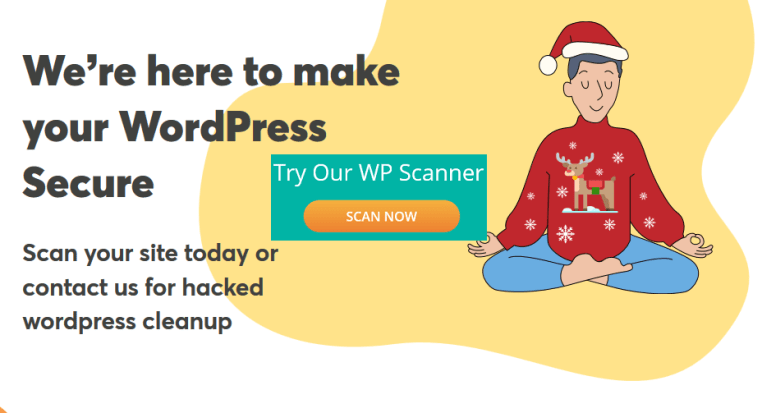
Website hacking is very common and a widespread problem in 2024. It is frustrating to find out that your WordPress website has been hacked. In this detailed article, you will know more about the most common reasons why hackers hack wordpress website and how to prevent them, you can simply avoid these mistakes and protect your site.Virtually any website can be a target of a hack. From little known blogs to robust eCommerce sites, cyber-vandals are always looking for easy prey. To top it all off, private information might not be the only thing that hackers are looking for. In most instances, your business is just another victim of cyber-vandals. However, at WP HACKED HELP, we take pride in being a proactive wordpress security solutions for small to medium business that are constantly connected to the web.
Table of Contents [TOC]
- 10 Most Common Reasons for WordPress Hacking
- 1. Using common passwords
- 2. Keep software updated
- 3. Check for your WordPress themes and plugins
- 4. Web Phishing / WordPress Phishing
- 5. Security policy loopholes
- 6. Improperly managed data
- 7. Unprotected Access to WordPress Admin Directory
- 8. Incorrect File Permissions
- 9. Using FTP instead of SFTP/SSH
- 10. Unsecure wp-config.php File
- Security tips to prevent website hacking
Why Would Someone Hack Your website?
- Easy for a beginner hacker to gain experience hacking, even if the hacker doesn’t have any malicious intent.
- Sheer popularity of WordPress makes it an easy target as lots of beginners dont focus on security aspects initially and they are not aware of the consequences.
- They can exploit resources such as outdated software, infected plugins or themes and use your site to infect your visitors with malware like backdoors, key trackers, WordPress ransomware, viruses, or other malicious software. At times hacker will redirect visitors from your site to other websites that would help them generate affiliate income. [For more info Read – WordPress malware redirect]
- Websites have valuable data, such as financial information. Read more on WordPress woocommerce hack
- They can take over your server and use it for sending out spam emails, performing DDOS attacks or brute force attacks .
- A SEO competitor may launch a hack attack to get your website blacklisted in google. This will have an adverse effect on your google rankings and Google will show this message in search results – “This Site May Be Hacked”
You can get more detailed info in this article on WordPress hacked and How to secure your site in 2024
A Bonus Tip:
Try our WordPress security scanner (click below) to find vulnerabilities which lead to website hacking, before a hacker does. We also provide malware removal services as well as a website security that will protect your site against future threats. Get in touch with us – CONTACT US
These are the most common points of entry into WordPress websites:
- 41% get hacked through vulnerabilities in their hosting platform
- 29% by means of an insecure theme
- 22% via a vulnerable plugin
- 8% because of weak passwords

10 Most Common Reasons for WordPress Hacking
1. Using common passwords

Compromised account details is a crucial concern that may result in an easy way to hack WordPress websites. The most common mistake is to set a password that is weak and simple to guess or deduce by trying variations of passwords. It is essential to create a password that is hard to figure out and also ensure not to use the same password for different websites. In addition, make use of security tools like two-factor authentication in WordPress.
Also Read – How To Change Your WordPress Username? – 3 Easy Ways
2. Keep software updated
An outdated software might not be equipped with a certain patches that may make it vulnerable to the hacks. Ensure that your web server software, CMS, plugins and other crucial softwares related to the website are all set for the automatic updation. If that option is unavailable, make it certain to manually update these softwares.
PRO TIP: Keep your WordPress Updated To Latest Version – See WordPress Releases
Also Read – WordPress Website Maintenance Tasks & Checklist
3. Check for your WordPress themes and plugins
It is essential that the WordPress themes and the plugins of the website are patched. Outdated themes, plugins, and WordPress version are the number one way hackers gain access to your site (besides brute force hacks of your login). Even deactivated themes and plugins can leave your system vulnerable. At the same time, ensure to delete the themes or plugins that are additional and no longer used for the site. Don’t disable these themes or plugins, rather, completely remove their files from your server. Also, carefully check for the free available version of paid plugins and themes before integrating them. The free versions are easy to be infected with malicious code.
Also Read – How to Scan & Detect Malware in WordPress Themes (Plugins Included)
WordPress Theme Security – Useful Links:
Reputable sources for WP Themes
4. Web Phishing / WordPress Phishing

Hackers more commonly use deceitful emails and web pages to mislead the user to gain confidential information. Phishing attacks more often makes one believe that they are dealing with a genuine webmaster, it involves tricking the user to steal confidential information , passwords, etc, into thinking you are a confidential site.. It is highly recommended that a user refrains from sharing personal information with someone they aren’t familiar with. But you can protect yourself from phishing schemes by following these tips to prevent phishing attacks.
5. Security policy loopholes

Certain security policies like permitting users to create weak passwords, easily giving away access to the admin and not enabling HTTPS on your site, can cause negative consequences. Google recommends to implement a strict security policy in order to protect the website. It advices to properly manage the user access and privileges, the logs are to be accurately analyzed and encrypted data is to be used.
Also Read – WordPress Vulnerabilities & How To Fix Them [AIO Guide]
Useful links:
- User Access Manager-plugin for WordPress allows you to manage the access of your content.
- User Role Editor – a dedicated WordPress plugin for managing various user roles and capabilities of your site.
- Advanced Access Manager – a simple but very powerful plugin for improving your website security and managing access to your posts, pages, widgets, menus, dashboard of your WordPress site.
- Capability Manager Enhanced – a user-friendly solution to manage different WordPress role definitions.
6. Improperly managed data
You website data is referred to as leaked when it is mishandled or improperly uploaded. Data leaks can result in hacking. Attackers may utilize the technique, Google dorking, in search engines to detect compromised data. Ensure that employees have an access only to the required data and also make use of URL removal tool to ensure Google doesn’t index sensitive URLs in search results.
Also Read – Disable Directory Browsing in WordPress
7. Unprotected Access to WordPress Admin Directory
Admin area is one of the most vulnerable area of wordpress and is most suseptible to hacking attempts. Leaving it unprotected is like leaving doors open for hackers. To protect it you can add layers of authentication to admin directory. You can also change WordPress admin username and setup two factor authentication as it adds an extra security layer, and anyone trying to access WordPress admin will have to provide an extra password.
Also read – How To Delete Invisible/Hidden Admin User In WordPress?
8. Incorrect File Permissions
One of the practical ways of offering security to your website is to set correct WordPress file permissions. File permissions set who has the authority to read, write, and execute the files that make up your website. Set them incorrectly and you end up leaving easy access to the important data/files of your website and the security can be easily jeopardized. In the worst-case scenario, a hacker may also add spam or malware.
9. Using FTP instead of SFTP/SSH

FTP accounts are used to upload files to your web server using an FTP client. Most hosting providers support FTP connections using different protocols. You can connect using plain FTP, SFTP, or SSH. Instead of using FTP, you should always use SFTP or SSH.
When you connect to your site using plain FTP, your password is sent to the server unencrypted. It can be spied upon and easily stolen.
Most FTP clients can connect to your website on SFTP as well as SSH. You just need to change the protocol to ‘SFTP – SSH’ when connecting to your website.
10. Unsecure wp-config.php File
WordPress stores your database information in the wp-config.php file. Without this information your WordPress website will not work, and you will get the ‘error establishing database connection error. Apart from database information, wp-config.php file also contains several other high-level settings. Since this file contains a lot of sensitive information,which makes it an important target for hackers.
Add an extra layer of protection by denying access to wp-config file using .htaccess. Simply add this little code to your .htaccess file.
|
1
2
3
4
|
<files wp-config.php>order allow,denydeny from all</files> |
Also read – WordPress .htaccess hack Cleanup & tips for extra security

Security tips to prevent website hacking
Implementing certain security tips can help secure your website from any type of hacks. Below listed are few of the points that you must consider to prevent website hacking:
- It is highly recommended to avail services from a renowned hosting provider. Such service providers create an unbreachable protective cover through updates and hardware solutions. The hackers may try to infect the website via other means but the companies are more cautious and equipped to fight against malware, Trojans, and other hack problems.
- Enable Two-Factor Authentication (2FA) for any service that requires you to log in with your credentials, including the contact form and login page. Adding a captcha to the contact and login forms can further enhance security and prevent automated attacks from bots. 2FA and captcha make it difficult for hackers to log in, despite having successfully stolen your password.
- Update your CMS, plugins, extensions, and perform a wordpress database backup regularly.
- The data used on the website should be secured locally in a password protected computer. You should also keep changing the account credentials from time to time.
- It is necessary for the website to be HTML encrypted, to avoid the misuse of data and ensuring it is safe even when shared with other.
- Ensure to verify the legitimacy of the customers, visitors on a post or for a click, instead of falling for a spam.
- Create and save your website related documents in a manner that they are not accessible by others. You may integrate a disallow button to avoid other users from accessing the document.
Follow our WordPress security checklist to safeguard your WordPress website with against various kind of hacks such as gibberish keyword hack, Japanese seo spam, WordPress XSS Attack, Pharma Hack & many more. However, it is preferable that you implement these security tips to secure wordpress site firstly.
Additional Useful Resources:
- Repair WordPress Database – Fix Corrupted Tables
- WordPress security tips
- Steps To Remove Malware From WordPress Site – WordPress Malware Removal Guide [doi.org/10.5281]
- HIPAA Compliance Security Checklist 2024
- Fix Google Ads Disapproved Due To Malicious or Unwanted Software
- WordPress Malware Removal Checklist




